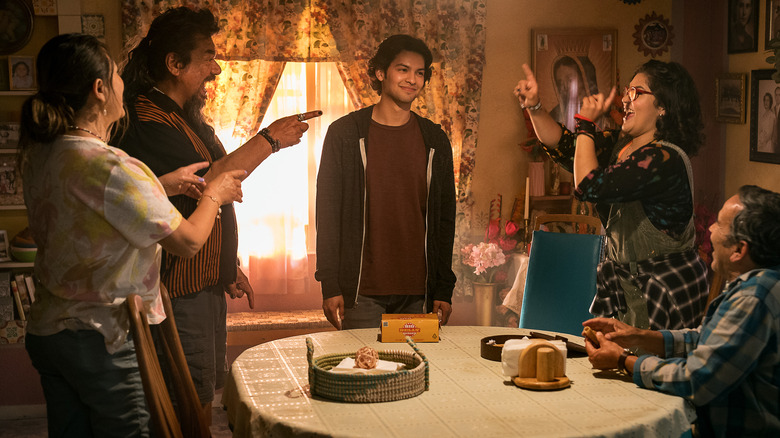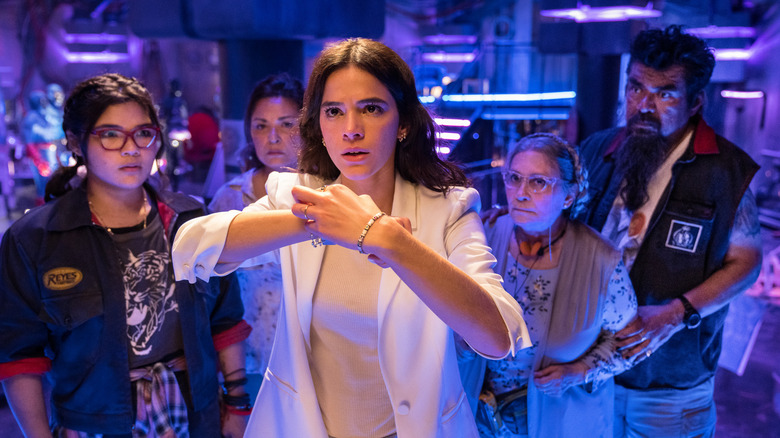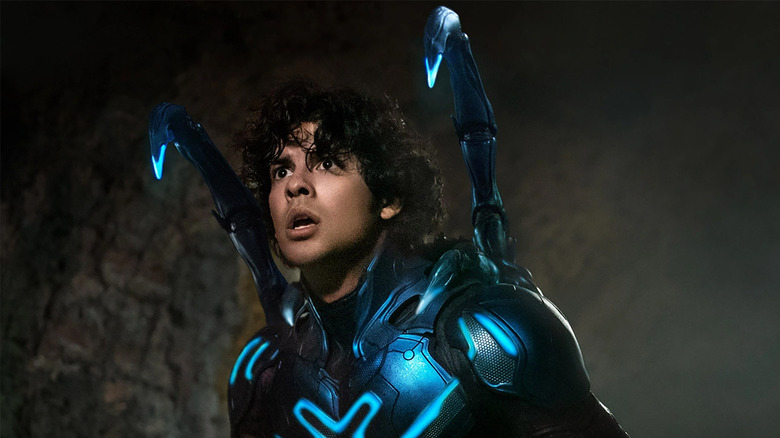Blue Beetle's Best Attribute Is Immersing Audiences In Mexican Culture
We have seen many, many superhero origin stories in recent years, to the point where they've started to blur a lot and stagnate the genre.
So it has become even more important to distinguish these movies with small differences, in tone, in scale, in the types of characters we see. It's why the more child-like humor in "Shazam" made it so fun and fresh, why the Disney Channel tone and focus on history in "Ms. Marvel" made it so special, and why the focus on family, as well as the cultural specificity of "Blue Beetle" are what make it stand out from all other superhero movies.
Indeed, this is a movie that, despite taking place in an entirely fictional city, has incredible specificity when it comes to the characters' Mexican background. From the way they speak Spanglish and Spanish, the slang they use, and the shows they reference, the movie immerses audiences in Mexican culture, mixing grounded culture and history with the fantasy of a superhero movie.
Speaking with /Film, director Ángel Manuel Soto talked about the importance of making the Reyes specifically, unequivocally Mexican, rather than making them some vague Pan-Latino family. "I think we've been psychologically and pathologically inculcated a fallacy by the hegemony that our specificity is not universal, that the white and gringo are universal," he said. "The truth of the matter is that we're all universal if we embrace our true selves." For Soto, the more specific the movie was, the bigger the audience it could reach, and he has a point.
An authentic family
Unlike most superhero families (the ones that aren't dead or in prison), the Reyes family in "Blue Beetle" is incredibly close, so much so that the only times they are not all together on screen is when the plot needs to split them up momentarily.
The movie avoids the trope of the hero struggling to keep his secret identity secret. Instead, the family is right there just as Jaime first gets his powers, and they continue to be with him the whole way. They are as scared as he is, they embrace his role as a hero as he does, and they always support him. Not just that, but they even get involved in the story rather than stay at home worrying. When Jaime is in trouble, the family gathers to rescue him, even after they had just faced an enormous loss.
And they are capable of fighting, like Nana, who has a secret past as a revolutionary. Indeed, the team took inspiration from real history, from the female Soldaderas who fought in the Mexican revolution, with Nana's braids taken straight from photos of the real thing.
This is the key to "Blue Beetle" and how it handles authenticity. It is a movie that, within the fantasy of a superhero story, pulls in from real history. This is what the best modern superhero movies do, like "Black Panther" taking from the colonization of the Americas, or how "Ms. Marvel" portrays the Partition of India.
Part of a bigger history
Of course, it is not all just references to tragedy, because "Blue Beetle" also takes every chance it gets to pay homage to great pieces of Mexican pop culture. Halfway through the film, Uncle Rudy helps Jaime infiltrate a secure facility and hacks into the security system by flooding their feeds with a stop-motion animated show familiar to every Mexican: "El Chapulín Colorado." The '70s show was a sitcom that spoofed superheroes, starring the eponymous hero with a heart of gold and zero powers. It is a small scene, but it helps set Jaime in a real-life context, as part of a long line of heroes of Mexican origin, blending the fantastical with the realistic.
Likewise, his family continuously makes fun of Jaime's crush on billionaire nepo baby Jenny Kord by comparing him to the eponymous protagonist of "María la del Barrio," a telenovela about a young girl from a low-income neighborhood that gets taken in by a rich businessman to work for the family, but ends up romantically involved with the businessman's son. The homages to these two shows canonize them, while also showing specifically Mexican references that nevertheless transcended borders.
"Though our countries have their own idiosyncrasies, truths and specific cultural identities, there are also more things that unite us within a Latin American collective," added the director. The references in the movie are both a celebration of the things that unite us collectively as Latino, and also references we are canonizing in this fictional world, forever making them part of a larger cultural legacy.


